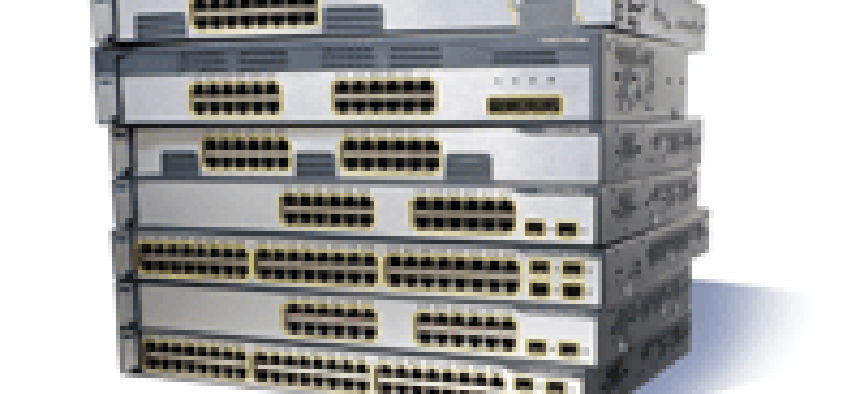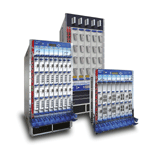Bandwidth wranglers

Ethernet has surpassed all other networking technologies in speed, scalability and ease of implementation.
Ethernet has surpassed all other networking technologies in speed, scalability and ease of implementation. It has become the global standard for networking, because it offers a standardized path from data centers and high-end servers across LANs, WANs and MANs to user desktops.In its gigabit and 10-gigabit forms, it can handle all types of bandwidth-intensive applications such as voice over IP, streaming video, medical imaging and high-end graphics, plus the burgeoning demands of the Internet.Today's 10-gigabit Ethernet and gigabit switch-routers are third-generation devices designed to keep pace with the real-world requirements of high-speed Ethernet networking. Called Layer 3 switches, multilayer switches, routing switches, switching routers or gigabit routers, they all pack switching and routing functions into the same chassis.Switch-routers operate at both Layers 2 and 3 of the Open Systems Interconnection model. Layer 2 switches forward traffic based on physical network addresses; they look up a packet's media access control address and forward it accordingly. Because they handle relatively low-level information, they are blindingly fast. They aren't very smart, however, because they don't know what is in the packets they forward.Layer 3 devices connect networks, not just devices, so they are more intelligent than Layer 2 switches. They determine the best path to a destination host over the network by looking at the header of an incoming packet, which contains the recipient's network address.Newer switch-routers are capable of providing Layers 4 through 7 switching. They are sometimes called content-aware, because they can offer application-level information to users. Gigabit Ethernet networks and delay-sensitive, high-bandwidth applications such as VOIP, video and iSCSI all benefit from Layer 4 classification, which allows session-by-session quality of service and end-to-end session management.The demand for gigabit and 10-gigabit products is robust and growing. According to a report by the Dell'Oro Group, a high-tech market research company in Redwood City, Calif., in 2004, shipments of gigabit ports exceeded those of fast Ethernet ports for the first time, and shipments of 10-gigabit ports grew more than 70 percent in two straight quarters last year."Attractive price points are making the decision to upgrade to modular gigabit relatively easy for many enterprises, as the total per-port average selling price of modular gigabit is only twice that of modular fast Ethernet," said Seamus Crehan, director of Ethernet switching for Dell'Oro. "Much of the growth in this segment is driven by larger enterprises deploying modular gigabit over copper in their wiring closets, which, in turn, is driving demand for 10-gigabit Ethernet to aggregate this traffic."For agency buyers, the most important feature of any new switch-router is whether it is IPv6-ready. IPv6 is the next-generation Internet protocol and is designed to fix the shortcomings of IPv4. It increases address size and offers better features, such as built-in security and quality of service."Full IPv6 support, including routing, quality of service, access control lists and IPv4 to IPv6 transition mechanisms, is an essential capability for high-performance Ethernet systems," said Gary Smerdon, chief executive officer of Greenfield Networks Inc. of Sunnyvale, Calif., which sells high-end chipsets for gigabit and 10-gigabit switches.IPv6 has been mandated for use in federal agencies by 2008, and most of the high-end 10-gigabit switch-routers in our guide either have it or are about to get it. About half are IPv6-ready.In general, 10-Gigabit switches are designed for large enterprises and service providers. Some, such the Enterasys Matrix-N Series, are designed to support core or edge routing at 10-Gbps rates, with services such as advanced quality of service for data prioritization, and granular control of bandwidth provisioning.Others, such as Broadcom Corp.'s new StrataXGS 600, are carrier-class switch-routers with multiprotocol label switching, service provider bridging, stacked Layer 2 services and other features.Their size, performance capabilities, scalability and high price tags define 10-gigabit behemoths. For example, Foundry Networks Inc.'s $26,246 BigIron MG8 offers wire-speed 480-Mbps routing and eight interface slots with up to 96 10-gigabit or 1,440 gigabit ports per seven foot rack.Of course, not every network requires 10-gigabit service. 100-Mbps Gigabit Ethernet continues to be the Ethernet of choice for many enterprises, particularly at network edges where gigabit speeds translate well into cost-effective throughput. And because not all applications require gigabit-scale speeds to the desktop, many gigabit switches provide 10/100/1000 combo ports that can be scaled up or down as needed.Gigabit switches are noteworthy for their smaller feature sets, performance capacities tailored to smaller network segments and affordable prices. They may be used anywhere in the network, including edge deployments and branch offices, small enterprise core switching, data centers and even for mission-critical workgroups or LAN wiring closets.Most gigabit switches in this guide include up to 48 combo ports, often with two or four gigabit stacking ports, are stackable and handle up to eight units per rack.Most of these units, priced between $1,200 and $5,000, come with robust management and security features, but don't expect the same quality of service, virtual LAN support and redundancy that you'll find in the big guys.Another big difference between current generation 10-gigabit switch-routers and Gigabit Ethernet switches is fundamental design. The larger switches are chassis-based, meaning they can accommodate upgraded line, fabric and supervisor cards for higher-speed ports and greater processing capabilities. Most gigabit switches are stackable, but without replaceable line cards, they cannot be easily modified or upgraded as chassis-based models can. In most cases, when you wish to add more feature sets, you'll have to buy new switches.

 Gigabit switches lasso high-end applications
Gigabit switches lasso high-end applications
J.B. Miles writes from Honomu, Hawaii. E-mail him at jbmiles@starband.net.

Juniper T-Series

Cisco Catalyst 3750 family
J.B. Miles writes from Honomu, Hawaii. E-mail him at jbmiles@starband.net.
NEXT STORY: GSA urged to resume post-award audits of vendors

